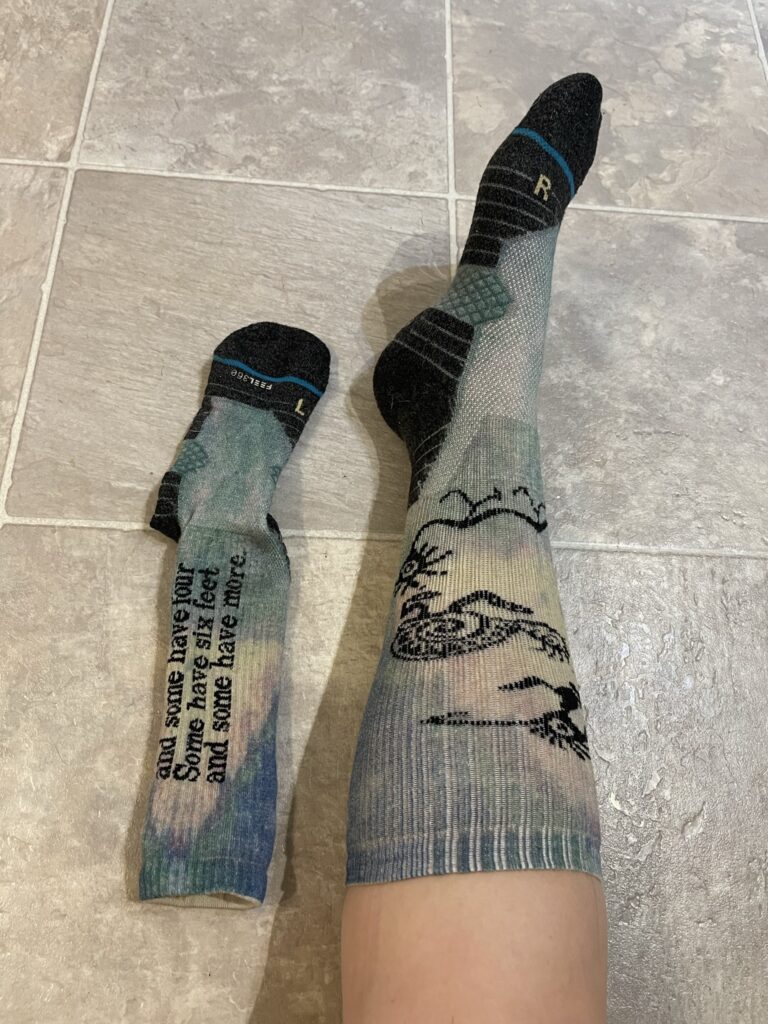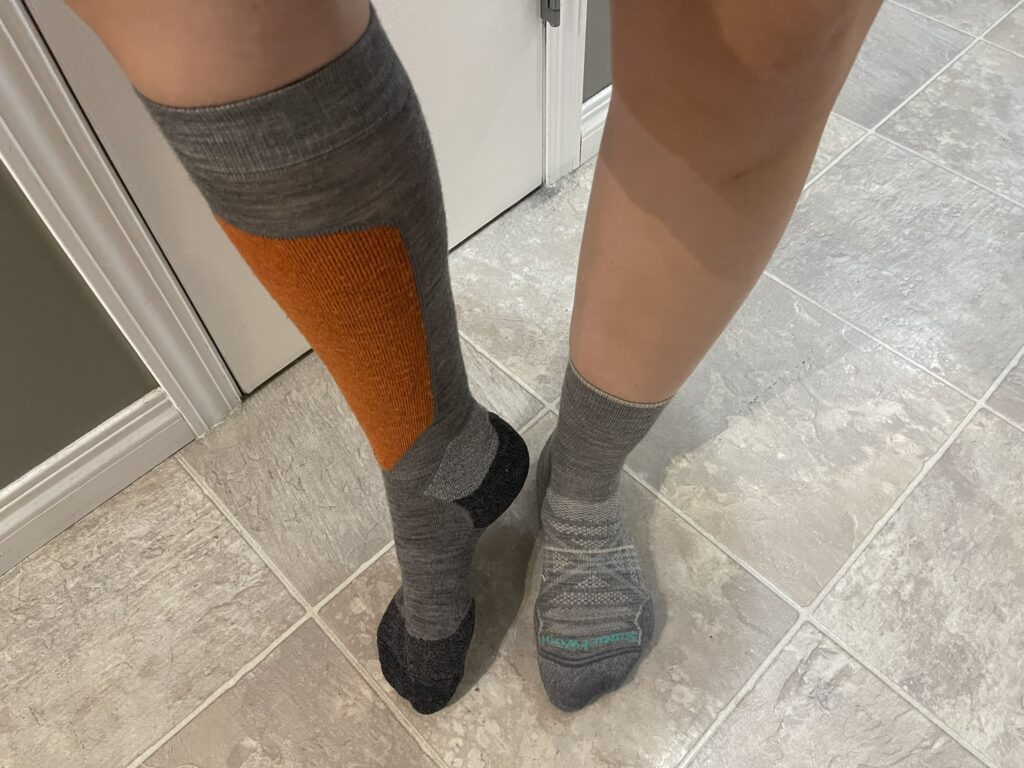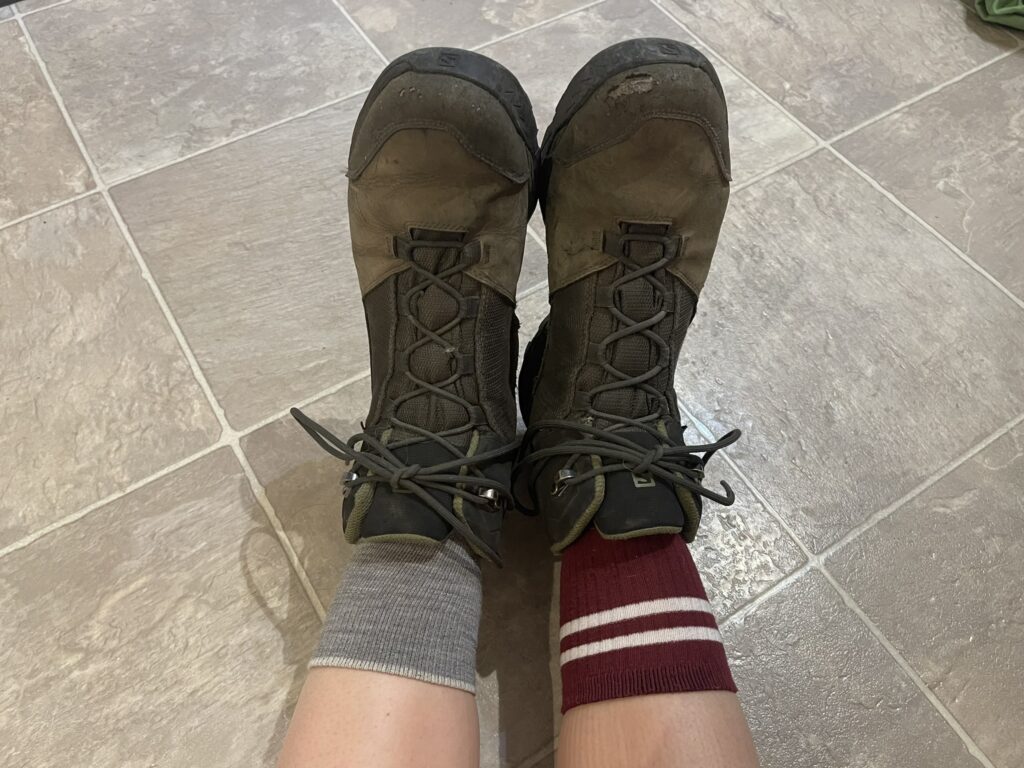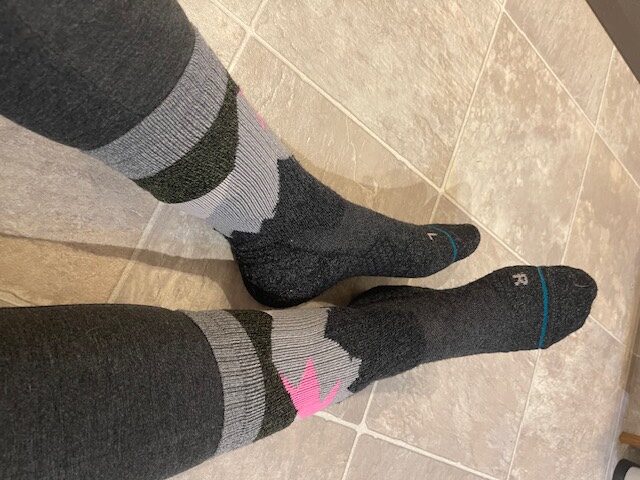There are many things to consider when figuring out how your hiking socks should fit, especially since they often can be quite expensive.
Should socks be tight or loose? Thick or thin? Should they offer compression?
Knowing how much of sock options is personal preference compared to proper fit can help you get the most out of your purchase and stay comfortable in the backcountry.
Should Hiking Socks Be Tight or Loose?
Hiking socks should be close-fitting and snug to your foot without being uncomfortable, cutting off circulation, or leaving deep impressions in your skin.
Hiking socks also shouldn’t be baggy or have the ability to bunch up underneath your foot.
It’s important to read the sizing guide on hiking sock packages (or product descriptions for online websites) and to buy the sock that is in your correct range. Quality hiking socks should have some sort of size or gender specifications listed.
Your sock should fit correctly when your toes are in the toe box, and the heel of the sock gently cups your actual heel without being manipulated into place.
You want your socks to be close to your skin so that they can absorb the sweat from your feet, and to prevent material from gathering and causing blisters.

3 Problems Caused By Hiking Socks That Are Too Tight
1. Decreases Circulation
If your socks are too tight, they may decrease circulation to your extremities, particularly if you have circulation problems to begin with, such as people living with diabetes or Raynaud’s.
The first problem with decreased circulation is that you may lose feeling to your toes. This becomes problematic if the boots you are wearing are on the tighter side, as you run the risk of jamming your toes at the front of your boot and causing trauma.
The second problem with decreased circulation is that it makes your toes colder. Blood circulating through your body is what keeps you warm. With less blood reaching your toes, they can have a hard time staying warm in cold weather.
Cold toes can be both painful and dangerous if not rectified in a timely manner.
2. Uncomfortable
Socks that are too tight can be generally uncomfortable. The entire sock might be too tight, or the fit might not be right for you, causing the sock to be too tight in particular areas.
Hiking socks that are too tight around the ankle will be uncomfortable when you bend your foot up at the ankle.
Hiking socks that are too tight around the calves may pinch when you walk or cause your foot to swell or go numb. A good indicator is if the pattern of your sock is stretched out and hard to distinguish.
Hiking socks that are too tight around the cuff might feel like a tight elastic band around your calf, and may leave an indent in your skin when you remove the socks.

3. Causes Swelling
If your socks are partially too tight in specific places, they might cause blood to pool below the area of constriction.
When blood pools and is unable to return to the hard, fluid is forced into extracellular spaces and causes swelling.
You might notice swelling around your ankles or mid-foot if portions of your socks are too tight.

6 Ways to Fix Socks That Are Too Tight
- Try stretching out socks that are too tight by placing them over a 2L bottle and letting the fabric stretch out over time.
- If you find that the sock fits your foot fine, but becomes too tight around your calves, look for socks that are labeled “wide calves”, “extra wide”, or “plus size”.
- Look for socks that are a polyester or wool blend with a higher nylon, spandex, or elastin percentage to add stretch to the sock.
- Try a different brand of socks. Sometimes one sock brand just doesn’t work with the way our feet are shaped. Try different brands to see if one works even better for you.
- Try a different height of sock. If you’re finding the cuff of your sock is too tight, it might be hitting your calf at the widest part of the muscle. Try ankle-height or knee-height socks to see if it makes a difference.
- Snip the socks at the tightest spot and repair the snips with a whipstitch. Not an ideal solution, but it might make an otherwise unusable pair of socks tolerable.
2 Problems Caused By Hiking Socks That Are Too Loose
1. Blisters
The biggest problem with hiking socks that are too loose is that they may cause blisters.
When your socks are able to rub against the skin if your foot, they will break down the skin where it rubs and cause painful blisters to form.
If socks are so loose that they fall down, they also might leave your heel exposed to the back of your shoe. This can also cause blisters when your heel rubs directly on the back of your hiking boots.
2. Discomfort
If hiking socks are too loose, they might fall down and bunch up underneath your foot.
Folds of sock underneath your foot can cause painful pressure points when you walk. This might additionally cause blisters, or may even change the way you weight your foot with each step, which also causes more pain.

4 Ways to Fix Socks That Are Too Loose
- Wear band-aids or tape. If the only problem that is occurring with your loose hiking socks is that you’re getting blisters, try protecting the area with band-aids or tape before putting on your loose socks.
- Roll down socks. Sometimes rolling down the socks and creating a “cuff” can take up the loose material and allow the socks to fit more snugly.
- Wear a sock liner. Sock liners also help to reduce blisters and help to absorb odors. Check out my post on wearing two pairs of socks for more information.
- Tuck socks into pants. If you’re wearing a tighter pair of pants for hiking, such as leggings or pants with a tight cuff, consider tucking the socks into the pants and using the tightness of the pants to hold your socks up.
How Tall Should Hiking Socks Be?
Hiking socks should be tall enough that they protect your skin from your gear. The exact height might differ depending on what you choose to wear.
For example, if you are hiking in the summer and your footwear doesn’t come above your ankles, you can likely comfortably wear ankle-height socks. Hikers who prefer shoes instead of boots often employ this technique.
If you’re hiking with a high-rise mountaineering boot, you might need a much taller sock – possibly up to your knees.
If you’re finding a mid-rise sock is uncomfortable due to the tight band along the top of the sock, try a knee-height sock.
Essentially, the height of your hiking socks comes down to personal preference so long as your skin is protected from rubbing.

Which is Better: Thick or Thin Hiking Socks?
The thickness of your hiking sock will largely depend on what temperature you plan on hiking in. Both thick and thin hiking socks are great for their specific conditions.
Thin hiking socks perform well in warm weather conditions by wicking away sweat without adding too much heat. Thick hiking socks are great in cold weather conditions by retaining heat while removing the moisture as well.
Thick socks also provide more cushioning to your foot, which you might be beneficial to you.
Thin socks might wear down faster than thicker socks. You might need a few pairs of thin hiking socks or plan to replace them more often than thicker pairs.
Check out my article on hiking socks vs regular socks to see why you shouldn’t replace hiking socks with regular socks, even if the thickness varies.
| Pros | Cons | |
| Thick Hiking Socks | Good for cold weather Last longer | Make feet sweaty in warm weather |
| Thin Hiking Socks | Good for warm weather Can layer for varying weather conditions | Wear down quicker Not great alone in cold weather |

Can I Wear Compression Socks Hiking?
Yes, you can wear compression socks for hiking!
Compression socks help to prevent swelling in the lower extremities and ensure adequate circulation to the toes as well. I have worn them hiking and really appreciate their benefits.
The material of compression socks becomes important, however, as many are made with a cotton blend. This might be fine for short hikes, but may leave you prone to blisters or cold feet.
If you love compression socks and want to wear them hiking, consider investing in a pair of hiking compression socks, which are made with merino wool or polyester instead of cotton.
Questions?
Drop a comment or question below and I’ll get back to you! Happy trails!

